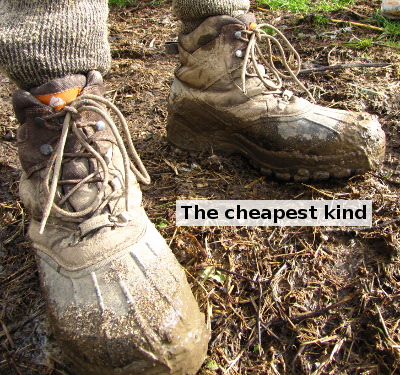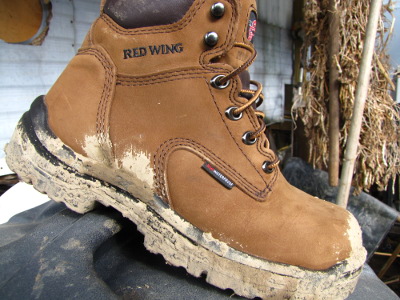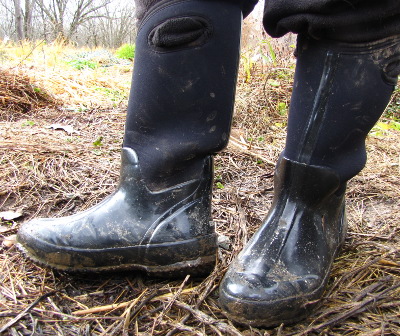
Farm boots
 Mark's take on shoes: It's
worth spending more to protect one of the most important parts of your
body.
Mark's take on shoes: It's
worth spending more to protect one of the most important parts of your
body.Anna's take on shoes: I work them so hard, the Wal-mart ones only wear out a few months faster than the expensive ones, so it's better to just get the cheapest kind.
Mark's
threat (offer?) to take me shoe-shopping came at a weak time.
We'd bought matching pairs of waterproof work boots at Wal-mart just a
month before since this same style lasted nearly two years for Mark
last time around. But my new boots came with a slow leak that
 quickly got bigger. I'd suffered through wet feet for three weeks
and was so sick of plastic
bags in my shoes that I was ready to grasp at any straw, even if it
was fancy, expensive, and stylish.
quickly got bigger. I'd suffered through wet feet for three weeks
and was so sick of plastic
bags in my shoes that I was ready to grasp at any straw, even if it
was fancy, expensive, and stylish.
We were in Ohio visiting
Mark's mom at the time, so she and Mark cooked up a plan to take me a
real shoe store. There, Mark shod me in two high priced pairs of
shoes --- calf-high Bogs ($95.95) for really wet weather and ankle-high
Red Wing work boots ($169.95) for drier periods. A little
research at home suggests that I could have reduced the price by about
15% by buying online (or by 35% if we'd selected an off-brand), but I
suspect Mark considers that extra price worth it because it allowed him
to strike while the iron was hot. (Or, rather, while cold, wet
feet were on the front of my mind.)
 So far, I can tell you that
both pairs of shoes are quite comfortable. The Bogs, especially,
are much superior to other types of muck boots I've worn since they
feel like real shoes (not flippers), they're warm, and they hug my calf
so that even when I wade through water too deep for the boots, my feet
don't get as wet.
So far, I can tell you that
both pairs of shoes are quite comfortable. The Bogs, especially,
are much superior to other types of muck boots I've worn since they
feel like real shoes (not flippers), they're warm, and they hug my calf
so that even when I wade through water too deep for the boots, my feet
don't get as wet.
The real question,
though, is how fast my expensive boots will wear out. I've pretty
much given up on wearing muck boots because I walk them into the ground
so quickly --- six months is a good lifetime for the cheap versions
under heavy farm use. Since my Bogs cost five times as much as
the cheapest boots, they'll need to survive until May 2014 to make it
worth our while. Think they'll make it?
Want more in-depth information? Browse through our books.
Or explore more posts by date or by subject.
About us: Anna Hess and Mark Hamilton spent over a decade living self-sufficiently in the mountains of Virginia before moving north to start over from scratch in the foothills of Ohio. They've experimented with permaculture, no-till gardening, trailersteading, home-based microbusinesses and much more, writing about their adventures in both blogs and books.
Want to be notified when new comments are posted on this page? Click on the RSS button after you add a comment to subscribe to the comment feed, or simply check the box beside "email replies to me" while writing your comment.

Rubber (rain/work) boots are generally made by injection moulding these days. They are generally made from PVC, (artificial) rubber or polyurethane.
These materials are usually not reinforced (although boots generally have a moulded-in liner). So while these materials are very flexible and tough, they are generally much easier cut or pierced than e.g. leather. So don't use your boots as an extra pair of hands to kick or shove things. The rubber will not appreciate it.
But a small cut or leak in them can be glued or sometimes even melted shut (with thermoplastic materials only). I think that in general rubber or PU boots are preferable. PVC requires softeners that will migrate out over time and ara potentially harmful.
For farm use you should probably consider steel-toed boots.
We bought Bogs while we were out visiting our homestead at the beginning of December. While we certainly didn't put them to any hard use, feeling like you're wearing slippers outdoors is pretty sweet and worthwhile in my opinion.
Sarah
http://mountainstead.blogspot.com
Anna, did you wear out the brand name Muck Boots?
The neoprene boots are sure warm in the winter. I were mine while trapping and went through the ice into thigh deep water one day. The initial shock of the cold water was intense, but the water in my boots quickly warmed to body temperature and was actually comfortable on the walk back to the truck.
Eric --- Interesting --- I had no clue the brand had a loyal following.
Roland --- Thanks for the science behind the materials! I have noticed that these are made of a different material than the really cheap ones (though don't know which each one is....)
I'm not a fan of steel-toed boots, though. In a perfect world, I'd be barefoot, which means I wear Tevas all summer (except when shoveling or mowing). Steel-toed boots are so darn restrictive....
Sarah --- They are very comfortable....
Anonymous --- That factored into our decision too. The shoe store was really cool --- half a sales outlet, but the other half was a real shoe repair shop! Worth the price of admission just to see and smell them working on leather.
Heath --- No, the ones I've worn out were whatever the cheapest brand is at Wal-mart.... I didn't realize "Muck boots" was a brand name. The warmth of these Bogs is definitely a major feature!
Heather --- I'll tell Mark you're impressed by him.
Would suggest treating those Red Wings with Sno Seal or similar waterproofing material. The leather will last longer.
When buying waterproof boots (that aren't rubber), GoreTex is the key.
The bottom of the boots looks like injection molded plastic. The top half looks like foamed neoprene maybe. The label inside should tell you which materials it is made of.
If you have steel-toed boots that restrict your toe movement, they're too small. I've found it comfortable to get steel-toed working shoes at least half a size bigger than normal.
I've found it comfortable to get steel-toed working shoes at least half a size bigger than normal.
Anonymous --- I was wondering if I should treat my boots with something to extend their life. I did try that one year, putting on waterproofing each time they got wet as instructed. And I still walked through a fancy, Gore Tex pair of boots in 12 months....
Roland --- Good tip with the label. It says, "Fabric upper. Balance rubber and manmade materials." Not that helpful, but sounds like maybe a blend of rubber and some kind of plastic?
I wear all of my boots too big because I just don't like feeling constrained (and my feet are awfully wide, so unless I get special shoes, I have to focus on width, not length.) And I still hated the steel toed boots I had once.
Edward --- Interesting comment about luck of the draw with cheap boots. I guess that's why Mark got those awesome ones and I got duds, all from the same brand....
Rhesa --- Those boots sound awesome! I wish I could get a pair of boots to last a fraction of that time.